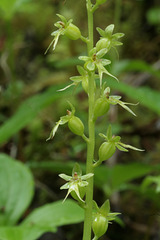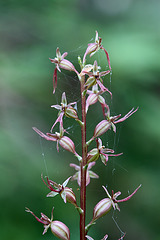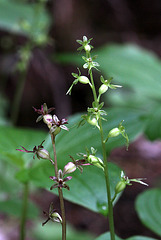RHH's photos with the keyword: twayblade
Heart-leaved Twayblade
| 12 Jun 2021 |
|
|
|
The Heart-leaved Twayblade, one of our native orchids, is a tiny plant that would probably not even be noticed unless one was looking for it. This example was photographed along the Baker Lake trail in the North Cascades.
Heart-leaved Twayblade
| 31 Jul 2018 |
|
|
|
Along Berg Lake we found hundreds of these tiny orchids, the Heart-leaved Twayblade and its relative the Northern Twayblade (see inset). The Heart-leaved Twayblade comes in two color forms, red and green and is often no taller than 8 cm.
Western Heart-leaf Twayblade (Listera cordata var.…
| 23 Jul 2009 |
|
|
I'm posting only one picture today for lack of time. This is one of the first orchids we saw while hiking the Berg Lake Trail in Mount Robson Provincial Park. It is a tiny plant with tinier flowers and would probably go unnoticed unless a person was actually looking for orchids. We also saw a purple form which I'll post at a later date.
Listera borealis (Northern Twayblade)
Western Heart-leaf Twayblade (Listera cordata var.…
| 29 Jul 2009 |
|
|
|
Photographed on the Berg Lake Trail, Mount Robson Provincial Park, British Columbia. We saw both the green-flowered and the red-flowered forms of this species. The green flowered form (fma. viridens) is shown below.
Northern Twayblade (Listera borealis)
Western Heart-leaved Twayblade
| 18 Jun 2012 |
|
Another of our native orchids, but one so small and with such tiny flowers that it is seldom noticed. The plant with its flower spikes is around six inches tall, though often smaller, and the individual flowers are a half an inch or less.
The plant can be found along many of the trails in our area, and often seems to be everywhere. We found these but a few plants on the grounds of the Au Sable Institute near Coupeville on Whidbey Island. It blooms all summer at different elevations.
The flowers range in color from green to a dark reddish-purple. These flowers are intermediate in color. The plant is named for the two opposite heart-shaped leaves that grow midway up the stem and which are more noticeable than the flowers.
ronaldhanko-orchidhunter.blogspot.com/2012/06/whidbey-isl...
nativeorchidsofthepacificnorthwest.blogspot.com/2012/05/c...
Listera banksiana
| 08 Feb 2013 |
|
Listera banksiana, the Northwestern Twayblade, is another of our rather nondescript native orchids. The plant is six inches to a foot tall and the flowers are around half an inch. It is quite common in the northwest, though this is a rare three-leaved form. Almost always it has two opposite leaves and I have not even seen a notice of a three-leaved form. This, too, was photographed at Lake Elizabeth in the North Cascades.
nativeorchidsofthepacificnorthwest.blogspot.com/2012/08/t...
Red and Green Forms of the Western Heart-leaved Tw…
| 06 Feb 2013 |
|
The Western Heart-leaved Twayblade, Listera cordata var. nephrophylla, is one of our smallest native orchids. It is found in two forms, the ordinary green form and a reddish form, fma. rubescens, often found growing together as they are here. The flowers are around half an inch in size, so small as to go unnoticed by most, though the plant is quite common. The plant has two heart-shaped, opposite leaves half-way up the stem which can be seen in some of the pictures at the link below. This example was photographed at Lake Elizabeth in the North Cascades.
nativeorchidsofthepacificnorthwest.blogspot.com/2012/08/t...
Listera banksiana
| 23 Mar 2013 |
|
|
This is another native orchid we found near Greenwater when hiking there last summer. Also known as Listera caurina, the Northwestern Twayblade is very common in our area and we seldom go on summer hikes in the mountains without seeing it. It's a small plant, usually a foot tall or less (30 cm) with rather insignificant half-inch (1 cm) flowers. The plant has two opposite leaves about half-way up the stem.
Jump to top
RSS feed- RHH's latest photos with "twayblade" - Photos
- ipernity © 2007-2025
- Help & Contact
|
Club news
|
About ipernity
|
History |
ipernity Club & Prices |
Guide of good conduct
Donate | Group guidelines | Privacy policy | Terms of use | Statutes | In memoria -
Facebook
Twitter










